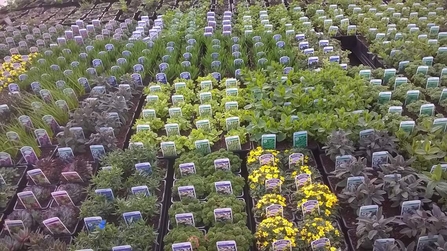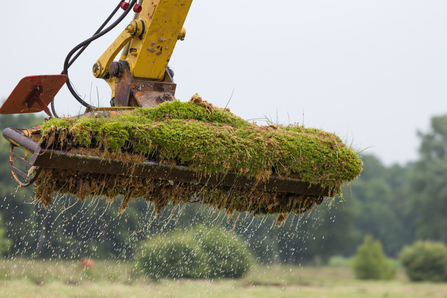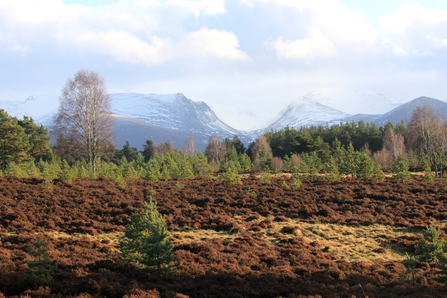Commercial peat extraction to generate peat as a product occurs mainly on raised bogs (but occasionally on blanket and fen peat) to provide peat for gardening, horticulture, whisky production, animal bedding and other uses. Mechanised peat removal has a major ecological impact, stripping away the living layer and, subsequently, exposing large quantities of peat to oxidation and loss of carbon. Neighbouring areas of peatland within the same hydrological unit can become degraded because of the drastically lowered water table. This means that the carbon, biodiversity and water quality impacts of peat extraction can reach far beyond the footprint of the extraction site itself. The threat to rare lowland peatland habitats and species, as well as the costs to society from the loss of peatland services such as carbon storage, water filtration and flood management, makes a strong case for ending the use of peat.
Peat removal has a major impact on peatlands. Credit Clifton Bain
Peat use in the UK
Currently, nearly three million cubic metres of peat are sold for horticultural use every year in the UK, one third of which comes from UK peatlands. The latest monitoring data from the Horticultural Trades Association (HTA) Growing Media Monitor Report (2022) shows that the overall proportion of peat in horticultural growing media fell from 41% in 2020 to 36% in 2021. The total quantity of peat used - 1,690,000 cubic metres - also decreased for the first time in eight years, with 600,000 cubic metres less peat being used in the sector in 2021 compared to 2020.
The retail market still accounts for most of the total volume of growing media used, making up 72% of the total market. The reduction in peat use has been greatest in this sector, with more immediate options for substituting peat than in the professional grower market. Some large retailers have voluntarily stopped selling bagged peat-based compost, although the sale of plug plants and bedding plants grown in peat is still widespread. Within the retail sector, peat now makes up about 30% of the materials used and this is set to fall further with retailer commitments to reduce peat use. Around 1 million cubic metres of peat is currently still being used for amateur gardening products.

Bedding plants at Quinky peat-free wholesale nursery in Cardigan, Wales. Credit Charles Warner
We are now moving away from the polarised debates between defenders of peat use and those against. There are common goals across the horticulture industry, with some nurseries now voluntarily peat-free, and many in the process of transition. However, complex supply chains and a lack of legislation to drive this forward mean that progress is slow. Important crops like mushrooms are largely grown in extracted peat, and although peat-free alternatives are increasingly available, mushroom growing accounts for around a ninth of the peat extracted in the UK.
As peat use by the horticulture sector reduces, other end users of extracted peat become more prominent. Small volumes of peat extracted from commercial extraction sites and more local hand-cutting sites are used in the food and drink industries, for example in whisky production. The industry recognises the need to ensure peat use is minimised and that the industry itself will need to play an increasing role in protecting and restoring peatland habitats.
Peat is still cut by hand for smaller industries such as whisky. Credit Emma Hinchliffe
Some localised extraction for domestic fuel continues, particularly in the Scottish Isles and in Northern Ireland, where it is an important part of cultural heritage.
Moving beyond peat in horticulture
Some permissions for peat extraction on existing sites extend up until 2042. The English government committed to ending the sale of horticultural peat for amateur gardening by 2024 with later bans planned for professional use, but this deadline was missed, and at the time of writing, legislation is still not forthcoming. In Scotland there have been calls to extend use beyond England’s proposed deadline for industry of 2030, and there has not been noteworthy progress towards ending retail sales of bagged peat compost. The Welsh government also said that peat compost sales would be phased out by the end of 2024, but failed to deliver on this promise. In Northern Ireland, references to the proposed 2025 ban on horticultural peat were removed from the 2022 update to the Peatland Strategy.
Existing peat extraction sites represent opportunities for restoration back to peatland habitat or intermediate land uses, such as paludiculture, [LINK TO ADAPTIVE MANAGEMENT WEBPAGE] which protect remaining peat extent but also offer the option to produce peat-free growing media. Large scale trials of growing Sphagnum as a ‘white peat’ replacement have shown promise in minimising greenhouse gas emissions from extraction sites whilst also delivering an economically viable product and wider benefits.

First mechanical harvest of cultivated peatmoss at a pilot Sphagnum farming site. Credit Tobias Dahms
Society demands urgent action by all sectors on the intimately linked crises of climate change and biodiversity loss. All businesses must respond to our global commitments to demonstrate sustainable practices and deliver net zero emissions.
Peat and Whisky
The whisky industry is worth £7.1 billion to the UK economy, and it supports 66,000 jobs. It accounts for approximately 22% of total UK food and beverage exports and is worth approximately 7 times more to the UK economy than chocolate, which is the next largest export in value. One of the key flavours associated with some whiskies is the flavour imparted to it using peat in the malting process.
Distillers create ‘expressions’ of whisky, which are different versions produced by the same distiller, often made by mixing different casks or ages of whisky. Some of these expressions are peated, some are un-peated, and some blend both peated and un-peated whiskies. Some distillers make no peated expressions, and some make only peated expressions. Islay is the location that is most strongly associated with the production of peated whiskies, but they are produced across Scotland, and indeed globally. It is not just the malting process that links peat and whisky: historically, illegal stills were even hidden in peatlands!

Lowland bog at An Camus Mor, Strathspey. Most extracted peat is taken from lowland bogs meaning that these habitats are one of the most pressured in the UK. Credit Badenoch and Strathspey Conservation Group
Reliance on extracted peat
The whisky industry uses between 6,000-7,000 tonnes of peat (dry weight) per year; this is an extraction amount of approximately 30,000 m3 per year. By comparison, the UK mushroom industry alone uses approximately 100,000 m3 of peat per year for growing mushrooms. The whisky industry is responsible for approximately 3% of extraction in the UK, with most peat being extracted for horticultural use. However, as UK governments discuss banning the extraction of peat for horticulture, this poses a dilemma for the whisky industry. If a ban occurs, whisky production will become the largest extractor. Some peat is also extracted and exported for whisky production overseas. While the extraction of peat for the Scottish whisky industry is permitted through Scottish Planning Policy (NPF4), we question whether extraction should be permitted on new sites or permitted for export to malt grain in other countries. Historic planning policy prevented the expansion of peat extraction activities to new sites, and we are already observing the impact of NPF4 with new extraction site applications.
“Development proposals for new commercial peat extraction, including extensions to existing sites, will only be supported where:
i. the extracted peat is supporting the Scottish whisky industry;”
National Planning Framework (NPF) 4, page 43
Sources of peat
The importance of the terroir of the peat - the environmental factors that influence the composition of the peat and the flavour it imparts - is often heralded. Some distillers claim that the provenance of the peat is critical for the flavour profile of their product. However, most of the barley used in whisky production is malted centrally, and a significant proportion of the peat used in the process is extracted from a limited number of locations. A small number of distillers produce their own malt with locally extracted peat. However, only one still cuts and produces 100% of its own malt. Peat cutting for whisky can have significant impacts on the landscape, as illustrated in the image below from an extraction site in Orkney.
Aerial image of peat extraction site at Hobbister, Orkney. Credit: Google Maps
There is also an emphasis placed on extracting peat locally to reduce emissions. However, where additional ingredients are imported for production, and given the scale of the global export market, this is likely to contribute very little offset compared to the detriment of opening a new extraction site and the carbon emissions [LINK TO CLIMATE REGULATION WEBPAGE] generated by damaging peatland.
The justification for demanding that peat is sourced locally should be examined to ensure it stands up to ever more stringent sustainability scrutiny. Peat soils are hugely variable. The peat has distinct characteristics as you cut through the layers of vegetation laid down over millennia, so what you cut last year may be different in plant composition to what you cut the next year. Peat characteristics change as a result of the peatland being drained and decomposing; peat extraction itself destroys the conditions under which the peat originally formed. Even in a local area, different bogs have distinct characteristics depending on slope and water chemistry. It is therefore our view that the need for local extraction is not always defensible on these terms. Extraction sites should be chosen carefully based on other sustainability criteria, considering water quality [LINK TO WATER QUALITY WEBPAGE] and biodiversity [LINK TO BIODIVERISTY WEBPAGE] impacts too.
Although some cutting is done by hand, most of the peat used in whisky production is extracted mechanically from lowland bogs using a variety of methods. We recognise that the whisky industry, and particularly those distillers with a long history of producing peated expressions, are in a difficult position with regards to producing a product that is sustainable and does not rely on an activity which damages peatlands. Research and trials to date have not been able to replicate the flavour profile of peat by other means. There are also restrictions around adding ingredients to whisky by law, and this includes the addition of artificial flavourings. However, new distilleries are producing peated expressions and we question the necessity of doing so, given the carbon emissions and finite nature of the resource.
Traditional hand cut peat blocks. Hand cutting is a technique that is used for the generation of peat bricks for domestic fuel, as well as being a technique that is used in some smaller distilleries to extract peat. Credit: Norrie Russell
The future of peated whisky
“Our Commitment to Responsible Peat Use, launched in 2023, outlines how our industry is extracting peat as responsibly as possible, using it efficiently, and driving peatland restoration. We support the International Union for Conservation of Nature (IUCN) UK Peatland Strategy 2040 [LINK TO STRATEGY WEBPAGE] and work closely with a growing network of stakeholders to advocate for a better understanding of peatlands and to promote further restoration activity across the country.”
We recognise that the Scotch Whisky Association (SWA) and some smaller collectives of distillers have made a commitment to sustainability, and this is to be applauded. However, this does not alter the fact that peat is a non-renewable resource. 80% of the UK’s peatlands are degraded, and contributing approximately 4% of the UK’s carbon emissions each year. Peat extraction disproportionately impacts lowland peatlands, which are some of the most threatened peatland habitats in Scotland: 95% of lowland raised bogs [LINK TO RAISED BOGS HABITAT PAGE] have been lost.
In view of the overarching Government commitment to combatting climate change, reducing peat use and restoring peatland habitat, the whisky industry has a responsibility to:
- Reduce use to essential activity.
- Keep peat use to a minimum: source peat responsibly, avoiding important wildlife sites, and seek to reuse peat removed as part of other planning developments.
- Ensure high standards of environmental care during operation to minimise impacts on water supplies, carbon loss and wildlife. Whisky companies should demand peat extraction operators adopt the highest standards and have statutory agency approved restoration practice.
- Ensure the highest standards of restoration on sites where peat is extracted – not just having after use plans in place, but phasing in restoration and ensuring funds are available to ensure restoration takes place after the extraction consent ends. There is a legacy of abandoned sites which have not been restored.
- Recognise the global challenge to restore peatlands, and the brand link between whisky and a healthy environment. The industry should play a key role in contributing to peatland restoration and go beyond their own extraction sites to support overarching goals to improve the condition of the UK’s peatlands.
Our work
The IUCN UK Peatland Programme has worked with several partners, including UK and devolved governments, to investigate the restrictions around peat extraction and site restoration. We have also supported research and policy to enable the development of sustainable, peat-free alternatives. We will continue to work with all partners, including those in the Peat-free Partnership, to support the introduction of a ban and any supporting guidance that may be needed post legislation being introduced.
Downloads
Demonstrating Success - Peat-free Horticulture Addendum 2023
Demonstrating Success - Peat-free horticulture 2021
Briefing: Commercial Peat Extraction (2014)
A discussion briefing for Scotland’s National Peatland Plan Steering Group (2016)
Review of extant planning permissions for commercial peat extraction in Scotland (2017)
Horticulture and Peat in Scotland - Roundtable Notes (April 2017)
